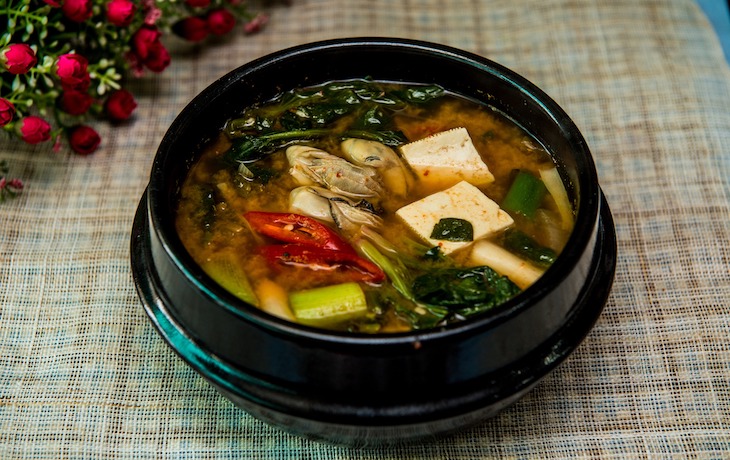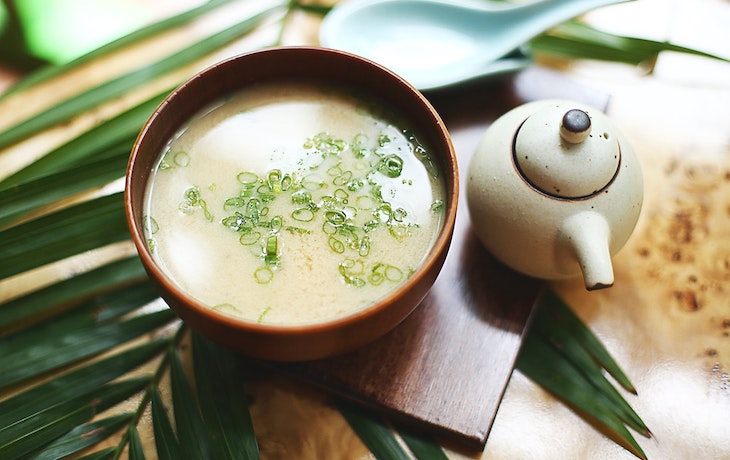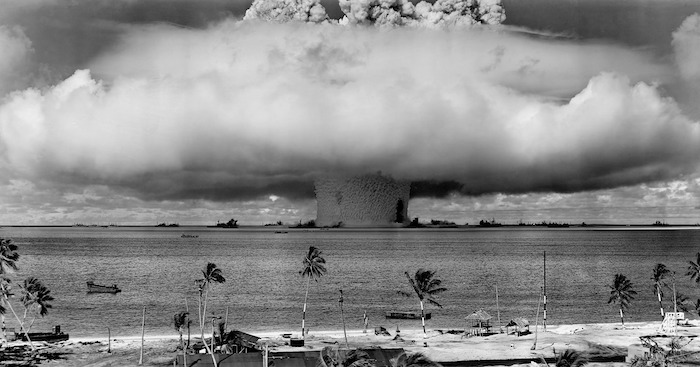Have you ever read something in a book that’s so outrageous and unbelievable that you want to throw the book across the room and do something else? I had that experience recently: there is reason to believe that miso soup can protect you from radiation poisoning because something about it helps catch and remove harmful contamination.
But instead of throwing the book, I reached for my phone and started researching. And while there isn’t definitive proof, there is indeed strong evidence that miso soup could be a mitigating factor if you’re exposed to radiation. At the very least, it’s cheap, tasty, nutritious, and unopened miso paste can sit on a shelf indefinitely.
Summary:
- Miso is a fermented soybean paste made from molded rice. It’s commonly served in Japanese cuisine as a soup.
- A study from Hiroshima University has demonstrated the potential for miso to prevent radiation poisoning, but not treat it after the fact.
- The protective qualities of miso seem to correlate with its fermentation, so opt for unpasteurized red miso that’s been aged longer, and don’t mix it with boiling water, which could kill off beneficial cultures.
- The story of miso being a ward against radiation started in 1945 when a medical team at Nagasaki suffered no radiation sickness after eating miso soup every day.
- Some are concerned about eating foods imported from Japan due to contamination from the 2011 Fukushima meltdown. You can ferment your own miso following the instructions in Wild Fermentation, but it takes one year or more.
Of course, don’t take any of this to mean that you can gulp a tub of miso and jump into a radioactive core (like a Japanese version of Popeye). However, if you anticipate radiation exposure, due to disaster or cancer treatment, consuming miso may help your odds.
What is miso?
Miso is a paste made from fermented soybeans. Most Western fermentations, like sauerkraut, are created with lactobacillus bacteria. However, miso is actually created with a mold, called aspergillus oryzae or kōji, which is grown on rice. In addition to miso, kōji is used to make soy sauce and sake.
Miso is a popular Japanese cuisine. The most common way to serve miso is as a soup, in which the paste is mixed into either dashi, some other sort of stock, or water. If you’ve eaten at an authentic Japanese restaurant, you’ve probably been offered a bowl as an appetizer, usually with tofu, little bits of seaweed, and green onion.
Fermented soybeans can be a difficult flavor (as anyone who’s tried nattō can attest), but miso soup is mild. You can also buy miso soup in a powdered form, which is favored by many Japanese office workers for its convenience — though we’re not sure the powdered stuff offers the same health benefits.
The Nagasaki catalyst
Miso gained its reputation as a radiation ward in the aftermath of the Nagasaki atomic bombing at the end of World War II. Sandor Katz tells the tale in his book, Wild Fermentation:
Dr. Akizuki was out of town the day of the bombing, and the hospital where he worked was destroyed. He returned to Nagasaki to treat survivors of the bombing. He and his staff ate miso soup together every day and never experienced any radiation sickness, despite their proximity to the fallout.
With apologies to Mr. Katz, my first instinct was that this story was either completely made-up or one of those random coincidences that doesn’t mean anything.
Dr. Tatsuichiro Akizuki recorded the experience in his 1981 autobiography, How We Survived Nagasaki, which is sadly long out of print (it appears to also go by the title Nagasaki, 1945, and I have an old copy on order). However, an excerpt of Akizuki’s account survives in an old Huffington Post article:
On August 9, 1945, the atomic bomb was dropped on Nagasaki. It killed many thousands of people. The hospital I was in charge of at the time was located only one mile from the center of the blast. It was destroyed completely. My assistants and I helped many victims who suffered from the effects of the bomb. In my hospital there was a large stock of miso and tamari (the liquid that comes off the miso during the fermentation process and also used as a condiment and soup stock). We also kept plenty of brown rice and wakame (a sea vegetable). So I fed my co-workers brown rice and miso soup. I remember that none of them suffered from the atomic radiation. I believe this is because they had been eating miso soup.
There could have been many other factors mitigating radiation poisoning. Why miso soup?
Over the years, the story spread, and when the Chernobyl disaster broke out in 1986, Europeans scarfed down miso soup to protect themselves from radiation.
In 2006, Dr. Hiroko Furo, an associate professor of Japanese studies at Illinois Wesleyan University, visited Japan to interview Dr. Akizuki’s wife and surviving patients from the Nagasaki bombing (Dr. Akizuki died in 2005). Many of the survivors attributed their survival to the miso soup diet, though Furo notes that not all of them ate it.
Furo concluded:
Although the data was collected from a relatively small group, this study illustrates that most survivors ate miso and that it was very helpful for survivors’ healing during the atomic bomb in Hiroshima and Nagasaki. In addition, the results show that Dr. Akizuki’s food helped to ease atomic bomb syndrome for survivors. These results can contribute to today’s society in many ways. First, the results can inform the public of the beneficial dietary effects of traditional Japanese food that is enriched with miso. This will lead to the recognition and reevaluation of Japanese culture and its traditional diet. Second, these findings can contribute to the future marketing of miso in the miso industry. It will also lead to changes to a diet enriched with miso, which is not only a condiment for food but also a probiotic in dry form with little salt. This information will be useful for those who are undergoing radiation therapy and may eventually contribute to the medical field of cancer treatment.
So is there any science behind Dr. Akizuki’s beliefs, or is it just a clever way to sell miso?
Recent scientific studies
In Wild Fermentation, Sandor Katz attributes the radiation-repelling properties of miso soup to an alkaloid called dipicolinic acid, which he claims “binds with heavy metals and carries them out of the body.” He cites a 2002 study by Rani Binita and N. Khetarpaul titled “Probiotic Fermentation: Effect on Antinutrients and Digestibility of Starch and Protein of Indigenously Developed Food Mixture.”
Unfortunately, that study isn’t freely available. I paid $14 to read it once but found no mention of dipicolinic acid, heavy metals, or even miso soup. The study revolves around fermenting a mixture of barley flour, dhal flour, skimmed milk powder, and tomato pulp. The researchers discovered that the fermentation made the mixture more digestible, which is cool (yay fermentation), but says nothing about miso soup’s effect on radiation.
However, that’s not the end of the road. Hiromitsu Watanabe, a biology professor at Hiroshima University, published a study in 2013 titled “Beneficial Biological Effects of Miso with Reference to Radiation Injury, Cancer and Hypertension” in the Journal of Toxicologic Pathology. Dr. Wantanabe was fascinated by the Nagasaki story and decided to test it, along with other claimed benefits of miso.
Dr. Wantanabe started with two groups of mice: one fed a commercial feed and the other fed with commercial feed mixed with red miso. After one week, the mice were irradiated and then autopsied 3.5 days later to compare intestinal glands (which he calls crypts).
They found that the miso group had a higher rate of intestinal gland survival than the control group.
However, feeding miso to the mice after irradiation seemed to have no effect. So Dr. Wantanabe concluded that the miso had to already be in their system before radiation exposure.
Dr. Wantanabe then wanted to find out whether the protective effect was from the soybeans or the fermentation process. He fed the mice miso in different stages of fermentation, along with a control group, and reached this conclusion:
However, when evaluating different types of miso provided by different areas of each institute, miso fermented for longer resulted in increased the numbers of surviving crypts, with the period of 180 days fermentation being considered significant. The mechanism of the radioprotective effect of miso is considered to be closely related to substances produced during fermentation stages.
Dr. Wantanabe also found that after a high enough amount of radiation exposure, the miso had no effect.
The soybeans in miso also contain genistein, which has been studied for its cancer-inhibiting effects.
In conclusion, Dr. Wantanabe found potential for miso soup to combat cancer, hypertension, and even radiation poisoning, but encouraged more study.
Grades of miso and getting the most out of it
The protective effects of miso are promising but still questionable. However, if you wish to mix miso into your diet for its many benefits, here’s what you need to know:
- There are three grades of miso: white, which is fermented for short periods of time; red: which is fermented for six months to a year; and black miso, which is fermented for two to three years but is extremely rare, even in Japan.
- Since fermentation seems to be the key to its protective properties, skip the white stuff and buy unpasteurized red miso.
- Buying (or making) unpasteurized miso is key so that the beneficial cultures are still alive.
- Yuko Smith, the proprietor of Saku Miso in Oregon, recommends eating raw miso to get the full benefits of fermented miso cultures. Boiling water kills those beneficial cultures.
If you want to make miso soup while still getting all of its benefits, boil the water or stock, let it cool to below 88° F, similar to if you were brewing beer or making a brine for fermentation, and then mix in your ingredients. That way, you get warm soup while not killing off the cultures.
However, some are concerned about eating foods imported from Japan, due to potential radiation contamination following the 2011 Fukushima meltdown. You can make your own miso at home, as documented in Wild Fermentation, but you’ll need some mature miso as a starter, as well as the kōji, which you can also make yourself if you purchase some aspergillus oryzae spores. You can use any kind of dry bean, not just necessarily soybeans. The process is fairly simple, but the fermentation takes one year or more.





You are reporting the comment """ by on